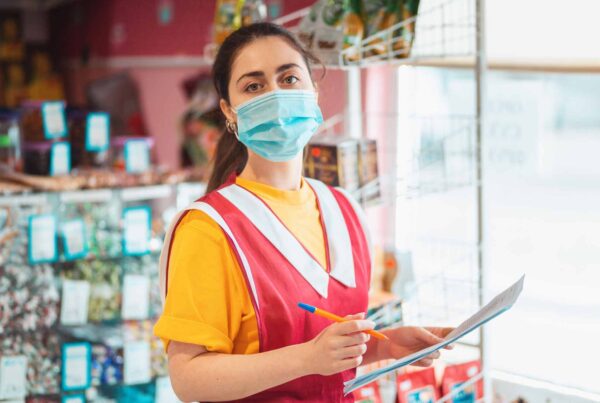By Rebecca Finkel
California was hit especially hard by the coronavirus pandemic this past summer, and a new report from the U.C. Berkeley Labor Center examines how much of that toll could have been avoided had the state maintained an adequate PPE stockpile. As California’s case numbers rose, a PPE shortage led to thousands of infections among essential workers as well as millions of dollars in unemployment insurance payments, due to more than 250,000 healthcare workers being unable to work.
After a few false starts, California was finally able to acquire a large order of PPE in July, but not before state officials were forced to buy PPE at markups of up to 300%. An April report by the L.A. Times found that some state officials paid up to $12.74 each for N95 masks that normally cost $3.40.
These early attempts were not only expensive, they were inadequate: by mid-summer, California was reporting an average of 10,000 cases per day. According to our PPE Shortage Index, California had the largest total number of requests in the country during that period, with N95-type masks the most requested type of PPE through July, when the state’s supply was finally refreshed.
Researchers from the U.C. Berkeley Labor Center investigated the costs of the crisis, expecting to create a budget figure for the next pandemic: the price the state would have to pay to save more workers’ lives. But what they found was something very different: Maintaining an adequate stockpile of PPE would not only save lives; it would save money. By their calculations, maintaining a PPE stockpile would cost the state 17% of the amount paid for PPE at inflated prices.
We spoke to one of the report’s authors, Dr. William Dow, Professor of Health Policy and Management in the School of Public Health at U.C. Berkeley, about the future of California’s stockpile, if the recent wildfires are putting pressure on the N95 supply, and how public health can be a good investment for any state.
Why was California’s PPE stockpile so depleted when the pandemic began?
Dr. Dow: California funded a large PPE stockpile in 2006, but the subsequent governor Brown, due to budget deficits, decided to discontinue maintenance of the stockpile. So the stockpile that existed when the pandemic began was not as large as intended, and some of it was expired. It was really a lack of political will to spend the money to maintain a stockpile.
Who supplied the up-priced masks mentioned in your report?
In California, many individual health care systems reached out to the private market to try to acquire masks. These were from many different suppliers that they were contracting with. The state attempted to enter into large contracts for purchasing masks. There was one very large contract that was canceled after the state decided that the contracted entity was not going to be able to follow through on the contract.
The contract that the state eventually ended up going with was a group called BYD, which is a Chinese conglomerate that had the ability to make masks. But delivery was delayed by months because federal regulators from NIOSH determined that the initial masks did not meet federal N95 standards. The contract was signed in early April, and NIOSH [National Institute for Occupational Safety and Health] certification was required by April 30th, but was not actually obtained until June.
It wasn’t until July, four months into the pandemic, that substantial amounts of masks were being shipped to California as part of this contract.
Did the federal government provide any assistance?
There may have been a small amount of masks that were transferred from the federal stockpile, but whatever the state was able to acquire and distribute was vastly insufficient in those initial months.
What made California so vulnerable to the effects of a PPE shortage?
Most states did not have an adequate stockpile, and most healthcare institutions did not have an adequate pandemic-level stockpile of their own. I’m not sure that I have a good answer of what would cause needs to be larger in one state than another.
It seems that you don’t need to have the size and population of California to experience these shortages. Get Us PPE has actually received requests from every state in the country.
Absolutely. I think that every state ought to be considering a bill similar to California’s SB-275 (Health Care and Essential Workers: personal protective equipment), and start planning a stockpile for the next pandemic.
Do you think that states should have PPE stockpiles for residents as well as for essential workers?
Yes, in the ideal world, states would have stockpiles available for residents. There were many different iterations and negotiations of the California bill SB-275, and the first priority was for essential workers. States should be stockpiling sufficient masks for essential workers and also create a legal requirement for health care organizations to have a pandemic level stockpile of PPE to reduce skimping if there are delays in state stockpile distributions. In addition, PPE stockpile plans should be sufficient for employees and residents in congregate living facilities, as well as schools.
Do you think that the state is taking seriously the threat of a future pandemic?
There are many different actors when we talk about the state. The legislature in California passed SB-275 to mandate the creation of another stockpile. The bill allows the stockpile to be created over the course of a number of years, so that we don’t try to purchase these materials during the middle of an ongoing pandemic.
The bill was not passed unanimously though, and as of mid-September the governor has not yet signed the bill. There was pushback from industry about the requirements for the health care sector to maintain their own stockpiles. Some were concerned about the logistical problems of planning for a stockpile during the current emergency, and some were concerned about the cost implications of beginning the stockpile, arguing that the state should maintain the pandemic stockpile rather than requiring healthcare providers to also have a stockpile. But they weren’t objecting to the notion of a stockpile — they framed their objections around costs and logistics.
Are the California wildfires further exacerbating PPE demand?
Yes. The N95 masks are particularly important during wildfires, for any residents who need to spend time outdoors, not just essential workers who are potentially coming in close contact with COVID-19-positive people. The first responders such as firefighters, obviously, need appropriate masks, in addition to the general population, and availability problems are exacerbated by the fires right now.
Do you think that the size of the proposed state PPE stockpile will need to increase due to climate change?
Estimating the exact size stockpile that’s needed is an imprecise science. We need to be worried about increased fires due to climate change, but I think if we can get a large stockpile period, then we’ll feel much better. The increased need due to fires co-occurring with a pandemic is only a small part of the need.
Do you think that framing this problem in terms of economic cost is an effective way to convince legislators to maintain their PPE stockpile?
I think that it’s very powerful. When I started our current research project, it was to try to estimate how many essential workers may have been infected by COVID-19 and potentially died because of inadequate availability of PPE. And I assumed that what I was then going to have to do was estimate how much it would cost to stockpile adequate PPE, and then assess whether the cost was worthwhile from a public health perspective. But what I actually found was that because the price markups were so large during the pandemic, we would actually save money if we had a stockpile. Because we know we’re going to be using these stockpiles in the future: more pandemics are coming.
The usual argument is that we have to justify what the right amount of spending is to prevent a certain amount of illness and death. That usual trade off wasn’t even necessary. I think that highlighting to the powers that be that we’ll actually save money if we can work on procuring the necessary stockpiles in advance, when we’re not in the middle of a pandemic emergency, should be a very effective line of argument.
Do you think that public health policies and economic policies go hand in hand?
There are certainly many types of public health investments which are going to save money, and we have dramatically underinvested in public health in this country. There’s good evidence that many types of public health investments would pay for themselves. Not all — we have to put together the evidence for which public health investments are the best buy. But compared to many things that we do in the health care sector, where we spend so much more money than in public health, public health is in general a much more cost-effective investment.




